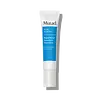What's inside
What's inside
 Key Ingredients
Key Ingredients

 Benefits
Benefits

 Concerns
Concerns

 Ingredients Side-by-side
Ingredients Side-by-side

Water
Skin ConditioningGlycolic Acid
BufferingRosa Damascena Flower Water
MaskingCentaurea Cyanus Flower Water
Skin ConditioningAloe Barbadensis Leaf Water
MaskingPropanediol
SolventGlycerin
HumectantTriethanolamine
BufferingAminomethyl Propanol
BufferingPanax Ginseng Root Extract
EmollientTasmannia Lanceolata Fruit/Leaf Extract
AntioxidantAspartic Acid
MaskingAlanine
MaskingGlycine
BufferingSerine
MaskingValine
MaskingIsoleucine
Skin ConditioningProline
Skin ConditioningThreonine
Histidine
HumectantPhenylalanine
MaskingGlutamic Acid
HumectantArginine
MaskingPCA
HumectantSodium PCA
HumectantSodium Lactate
BufferingFructose
HumectantGlucose
HumectantSucrose
HumectantUrea
BufferingHexyl Nicotinate
EmollientDextrin
AbsorbentCitric Acid
BufferingPolysorbate 20
EmulsifyingGellan Gum
Trisodium Ethylenediamine Disuccinate
Sodium Chloride
MaskingHexylene Glycol
EmulsifyingPotassium Sorbate
PreservativeSodium Benzoate
Masking1,2-Hexanediol
Skin ConditioningCaprylyl Glycol
EmollientWater, Glycolic Acid, Rosa Damascena Flower Water, Centaurea Cyanus Flower Water, Aloe Barbadensis Leaf Water, Propanediol, Glycerin, Triethanolamine, Aminomethyl Propanol, Panax Ginseng Root Extract, Tasmannia Lanceolata Fruit/Leaf Extract, Aspartic Acid, Alanine, Glycine, Serine, Valine, Isoleucine, Proline, Threonine, Histidine, Phenylalanine, Glutamic Acid, Arginine, PCA, Sodium PCA, Sodium Lactate, Fructose, Glucose, Sucrose, Urea, Hexyl Nicotinate, Dextrin, Citric Acid, Polysorbate 20, Gellan Gum, Trisodium Ethylenediamine Disuccinate, Sodium Chloride, Hexylene Glycol, Potassium Sorbate, Sodium Benzoate, 1,2-Hexanediol, Caprylyl Glycol
Salicylic Acid 2%
MaskingWater
Skin ConditioningAlcohol
AntimicrobialHamamelis Virginiana Water
AstringentPropanediol
SolventPentylene Glycol
Skin ConditioningGlycerin
HumectantSilica
AbrasiveButylene Glycol
HumectantPolyacrylate Crosspolymer-6
Emulsion StabilisingC12-15 Alkyl Lactate
EmollientAesculus Hippocastanum Seed Extract
Skin ConditioningAvena Sativa Kernel Extract
AbrasiveUrea
BufferingYeast Amino Acids
HumectantTrehalose
HumectantInositol
HumectantTaurine
BufferingBetaine
HumectantThymol
AntimicrobialTerpineol
MaskingHydroxyphenyl Propamidobenzoic Acid
Skin ConditioningButyrospermum Parkii Butter
Skin ConditioningShea Butter Ethyl Esters
Emollient4-T-Butylcyclohexanol
MaskingDisodium EDTA
Sodium Hydroxide
BufferingSalicylic Acid 2%, Water, Alcohol, Hamamelis Virginiana Water, Propanediol, Pentylene Glycol, Glycerin, Silica, Butylene Glycol, Polyacrylate Crosspolymer-6, C12-15 Alkyl Lactate, Aesculus Hippocastanum Seed Extract, Avena Sativa Kernel Extract, Urea, Yeast Amino Acids, Trehalose, Inositol, Taurine, Betaine, Thymol, Terpineol, Hydroxyphenyl Propamidobenzoic Acid, Butyrospermum Parkii Butter, Shea Butter Ethyl Esters, 4-T-Butylcyclohexanol, Disodium EDTA, Sodium Hydroxide
 Reviews
Reviews

Ingredients Explained
These ingredients are found in both products.
Ingredients higher up in an ingredient list are typically present in a larger amount.
Glycerin is already naturally found in your skin. It helps moisturize and protect your skin.
A study from 2016 found glycerin to be more effective as a humectant than AHAs and hyaluronic acid.
As a humectant, it helps the skin stay hydrated by pulling moisture to your skin. The low molecular weight of glycerin allows it to pull moisture into the deeper layers of your skin.
Hydrated skin improves your skin barrier; Your skin barrier helps protect against irritants and bacteria.
Glycerin has also been found to have antimicrobial and antiviral properties. Due to these properties, glycerin is often used in wound and burn treatments.
In cosmetics, glycerin is usually derived from plants such as soybean or palm. However, it can also be sourced from animals, such as tallow or animal fat.
This ingredient is organic, colorless, odorless, and non-toxic.
Glycerin is the name for this ingredient in American English. British English uses Glycerol/Glycerine.
Learn more about GlycerinPropanediol is an all-star ingredient. It softens, hydrates, and smooths the skin.
It’s often used to:
Propanediol is not likely to cause sensitivity and considered safe to use. It is derived from corn or petroleum with a clear color and no scent.
Learn more about PropanediolUrea is also called carbamide and is the diamide of carbonic acid. In cosmetics, urea is used to hydrate the skin. It also provides exfoliation in higher concentrations.
As a humectant, urea helps draw moisture from the air and from deep within the skin. This helps hydrate your skin. Studies show urea is an effective moisturizer for dry skin conditions. 40% urea is typical in medications for treating eczema and other skin conditions.
Urea has the strongest exfoliation effect in concentrations higher than 10%. It is a keratolytic agent, meaning it breaks down the keratin protein in the top layer of skin. This helps remove dead skin cells and flaking skin.
In medicine, urea has been shown to help increase the potency of other ingredients, such as fungal treatments.
Humans and animals use urea to metabolize nitrogen-containing compounds. Urea is highly soluble in water. Once dissolved, it is neither acidic nor alkaline.
Learn more about UreaWater. It's the most common cosmetic ingredient of all. You'll usually see it at the top of ingredient lists, meaning that it makes up the largest part of the product.
So why is it so popular? Water most often acts as a solvent - this means that it helps dissolve other ingredients into the formulation.
You'll also recognize water as that liquid we all need to stay alive. If you see this, drink a glass of water. Stay hydrated!
Learn more about Water